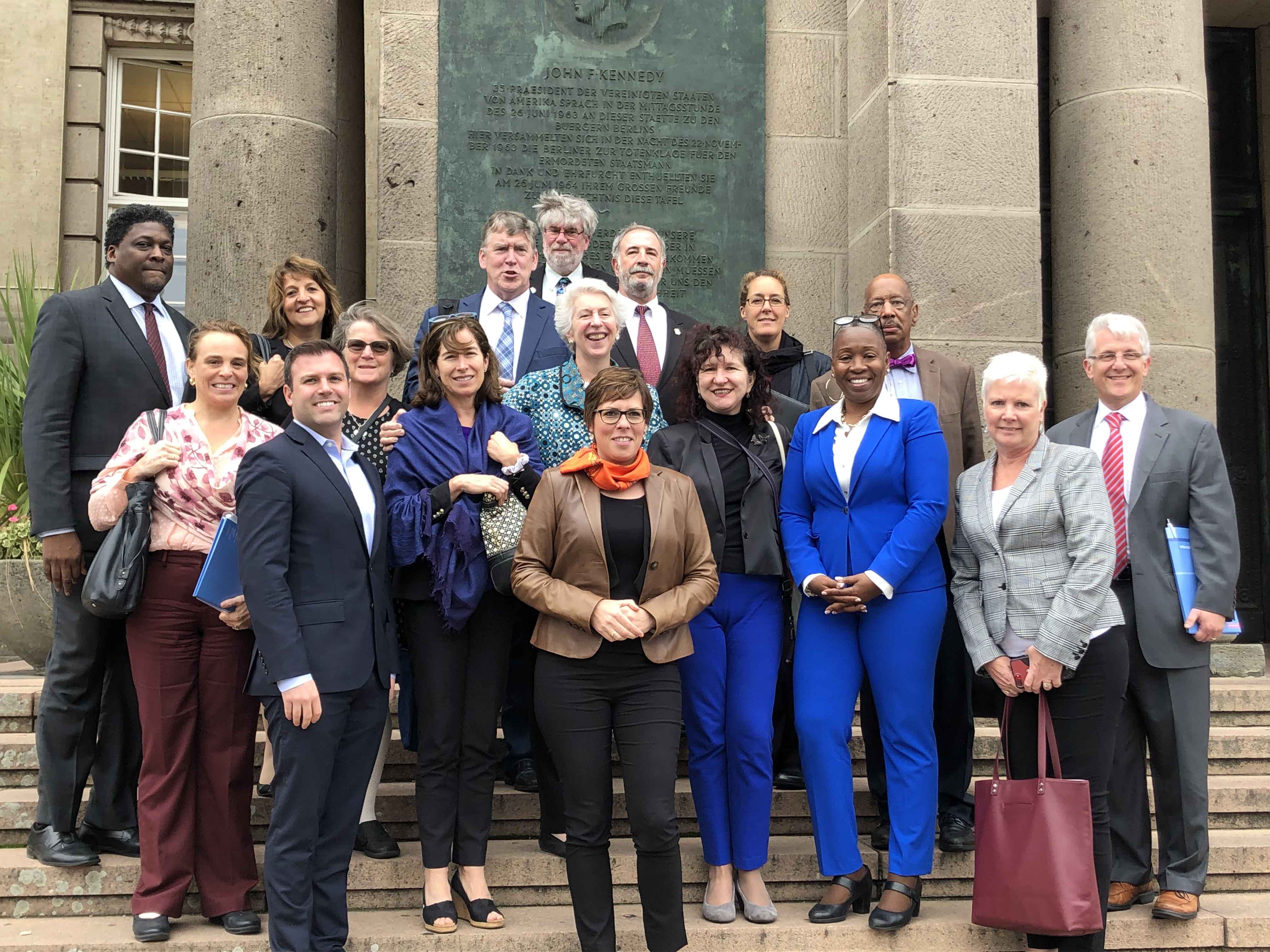ETC overseas: exploring Germany’s dual-education model
This article appears in the 2019-2020 edition of CSG East’s Perspectives Magazine.

Members pose for a photo at the Rudolph Wilde Platz in Berlin, the site of President John F. Kennedy's famous "Ich bin ein Berliner" speech on June 26, 1963. Credit: Veronique Cavaillier
For years, Joan Dolan has searched for vocational training programs that offer youth a pathway to meaningful careers without the need for a college degree — careers that will hopefully keep them in Maine, her home state.
“Everybody is screaming for employees,” said Dolan, who is director of apprenticeships and strategic partnerships at the Maine Department of Labor. “There is not an easy way right now to connect our youth to those employers.”
With one-fifth of its residents above the age of 65, Maine has the oldest population in the nation. Despite a 3.5 percent unemployment rate, many young people leave the state after high school.
Dolan had heard that a few states facing similar challenges had partnered with companies to create apprenticeship programs based on Germany’s dual-education model. The program trains high school students for skilled jobs and then transitions them into middle-class careers. Dolan was intrigued by the program’s success and durability, and when she learned that the Eastern Trade Council (ETC) was leading a delegation of two dozen northeastern state officials to Berlin to study the program, she was eager to join them.
The German system was created in 1969 through legislation known as the Vocational Training Act. The program, which is regulated by the federal government, pairs small and medium-sized companies with publicly funded vocational schools. It is primarily aimed at youth who are interested in entering the work force without attending college; apprentices can start training as early as age 15. Currently, about 500,000 students — half of all graduating high school seniors — enter directly into apprenticeships in lieu of pursuing higher education. Companies pay approximately three-quarters of the cost of the dual-education program, and the federal and state governments pick up the balance.
Last October, Dolan traveled to Berlin with officials from six other states to see the program in action. Over the course of five days, ETC organized nearly two dozen meetings with representatives from federal, state, and city governments; national and regional chambers of commerce; trade associations; start-ups; small businesses; and incubators focusing on the life sciences and renewable-energy industries.
“I’ve always heard about the German model, but I really understand it now,” said Dolan. “My big takeaway was that they’ve got it figured out, and we should be applying it here as we can.”
Creating Alternative Pathways to Employment
Dolan said one of the benefits that struck her about Germany’s system is that it gives youth time to try out a potential career with little financial risk. Over a period of up to three years, apprentices spend three-quarters of their time training in the workplace; the rest of the time is devoted to classroom instruction at a vocational school. The classes include coursework focused on a particular industry, but participants are also required to take subjects to broaden their overall education, including courses in political science and communication.

Members visiting the HySPRINT Lab, a major renewable energy research hub owned by the Helmholtz- Zentrum Berlin Corporation. Credit: Veronique Cavaillier
During the program, apprentices are mentored by experienced employees at a company and receive a paycheck equal to one-third of the pay they would earn working in a full-time position. Graduates are awarded a journeyman certificate and then typically go straight into a full-time job, either at the company where they trained or at another firm within the same industry. Others travel or go on to college to get more experience in their chosen field.
Dolan said she was surprised to learn about the robust opportunities offered to youth in Germany, where the average age of an apprentice is 19. There were few parallels in Maine, where most apprenticeships are unionized and only available to union members. Typically, the programs are not open to entry-level employees; the average age of an apprentice in Maine is 30. For high school graduates looking for an alternative to college, the only option is often a low-wage, dead-end job that will not lead to a viable career, at least in the near term.
“We send our kids to college and say, ‘Go figure yourselves out and incur $200,000 in debt,’” said Dolan. “I think everybody should have an occupation that can allow them to earn a livable wage, but college isn’t always the answer.”
Based in part on what Dolan learned in Berlin, her agency has contacted a technical high school about developing a registered apprenticeship program to train students to become automotive technicians. Currently, the high school has an agreement with a local community college, which offers students coursework that counts for one year toward a two-year degree. Once students graduate, they tend to go straight to work without completing the final year of study. Her hope is to create a new program that will enable students to get hired after the first year but require that they complete the degree to stay employed. Ultimately, getting the two-year associate’s degree will create more options for those students down the road. And as in Germany, attending classes at the community college would be free.
“I am definitely taking what I learned there and weaving it in with what I hope will be a robust youth apprenticeship program in Maine,” said Dolan. “We’re trying to create an alternative pathway to a stable, fulfilling career with growth opportunities.”
No Silver Bullet
Of course, part of the challenge lies in persuading employers to create programs to attract young workers. The dilemma is not unique to Maine. Within seven years, more than 15 other states will have at least one-fifth of their population beyond retirement age, including four in the Northeast: Delaware, New Hampshire, Pennsylvania, and Vermont.
Vermont State Senator Alison Clarkson, who joined Dolan on the trip, estimates Vermont currently lacks at least 10,000 skilled workers to fill open jobs in various professions. The shortage has forced companies to cast a wide net in search of qualified candidates — a situation that has created a silver lining for some workers whom companies may have passed over in the past, like ex-offenders.
“Employers are looking at groups of employees they never thought they’d consider. And they’re finding that these people are good workers,” said Clarkson, who is vice chair of the Senate Committee on Economic Development, Housing, and General Affairs, where she is tasked with work force development.
Clarkson said that one of her takeaways from the trip to Berlin was the breadth of the German system, which offers apprenticeships in 360 professions, compared with 28 in Vermont. Clarkson plans to introduce a bill next session that would double the number of programs offered in Vermont over five years.
Clarkson observed that even in Germany, where apprenticeships have their roots in the guild system dating back to the 13th century, there is room for improvement when it comes to work force development. Many companies still experience shortages of skilled workers, which is partly the consequence of an aging population and also results from the flexibility built into the dual-education system. Once apprentices graduate, they are not compelled to take a job at the company that trained them. Some choose to enroll in the university — which offers free tuition — or look for work at a different company. Since Germany’s system is standardized, employers know that all graduates within a profession receive the same level of training nationwide.
“It was interesting to see that they face some of the same challenges we do. They don’t have a silver bullet for this,” said Clarkson. “But it’s always great to be exposed to new ideas — these trips are professionally and culturally expanding for us. We dispelled some myths, and we took on some new models that we can make work in our own states.”




